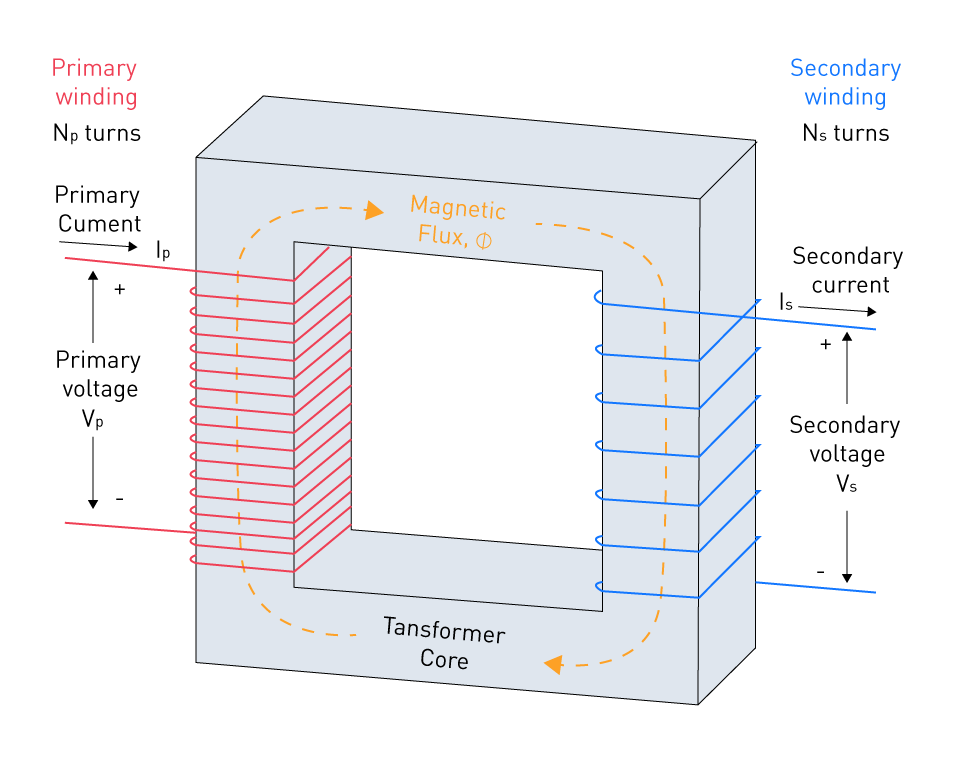Definition and Role in AC Power Systems
Transformers are essential components in electrical engineering and play a crucial role in the operation of alternating current (AC) power systems all over the world. A transformer is a type of electrical device that uses electromagnetic induction to transfer electrical energy between two or more circuits. Without altering the frequency of the electrical energy, it is able to accomplish this by transforming alternating current (AC), which has one voltage level, into another voltage level, which can be either greater (stepped-up) or lower (stepped-down). This fundamental principle underpins the widespread application of transformers in the generation, transmission, and distribution of electrical power.

Figure 1: Block diagram of a single-phase transformer
Definition and Principle of Operation
Two or more windings surround a ferromagnetic material core, which forms the core of a transformer. The primary and secondary windings, also known as coils, are the circuits that correspond to the input and output circuits, respectively. These windings are recognized by their respective names. The system insulates this winding from both the earth and the other windings in it. Oil or another suitable liquid submerges the core and winding assembly within a metal tank, cooling and insulating them. The flow of an alternating current through the primary winding generates a fluctuating magnetic field in the core. This, in turn, induces a fluctuating electromotive force (EMF) across the secondary winding. The transformer's voltage transformation characteristics are determined by the ratio of the number of turns in the main winding to the number of turns in the secondary winding.

Figure 2: Transformer
Role in AC Power Systems
There are several facets to the role that transformers play in AC power networks, and they are absolutely necessary. Transformers effectively transport electrical power over great distances, significantly reducing the energy loss that would occur at lower voltages. Transformers are responsible for ensuring that consumers receive electrical power in a manner that is both safe and efficient. They achieve this by increasing the voltage at the generator site and then lowering it closer to the consumption point.
Voltage Regulation: Transformers offer the capability to modify voltage levels in order to fulfill the specific requirements of various applications. Industrial facilities require high voltages, while domestic settings require lower voltages.
Interconnection of Grids: Transformers enable the interconnection of electrical grids operating at different voltage levels. This improves the entire power system's stability and flexibility.
Integration of Renewable Energy: Transformers, which transform generated electricity into voltages suitable for grid distribution or direct use, are essential parts of renewable energy systems like wind farms and solar photovoltaic parks.
Isolation and Protection: Transformers' ability to provide electrical isolation between circuits is essential for ensuring safety and protecting against electrical surges and faults. Transformers can also provide protection against electrical surges.
Importance of Transformers in Electrical Power Distribution
Transformers are absolutely necessary components within the architecture of electrical power distribution networks. Because of the key role that they play in changing voltage levels, they are absolutely necessary for the distribution of electrical energy from power plants to end-users in a manner that is efficient, safe, and dependable. A number of essential features of the design and operation of power systems highlight the transformer's important role in satisfying the requirements of modern electrical infrastructure, highlighting its relevance.
Enabling Long-Distance Power Transmission: Transformers are essential in the field of power distribution for a number of reasons, one of the most important of which is their capacity to increase voltage levels to enable long-distance power transmission. High-voltage transmission connects remote power-producing facilities with customers in far-flung urban and rural areas, minimizing electricity loss over vast distances. Transformers must reduce the high-voltage electricity to safer and more usable levels for residential, commercial, and industrial applications once it reaches its destination. This two-step procedure, which involves increasing voltage for transmission and decreasing voltage for distribution, is essential to the functioning of electricity grids worldwide.
Enhancing Electrical Safety and Accessibility: This is also an essential component in the process of ensuring the safety of electrical systems. Transformers safeguard not only the power distribution network infrastructure but also the appliances and devices used by consumers. They do this by regulating the voltage to the appropriate levels based on need. They make it possible for high-capacity power systems to interact safely with the finely tuned requirements of end-user equipment, reducing the likelihood of damage or hazards occurring as a result of voltage levels that are not appropriate.
Facilitating Grid Interconnectivity and Flexibility: Transformers are able to provide grid interconnectivity and flexibility because of their versatility. This enables the interconnection of a wide variety of power-generating sources with different areas of the grid that operate at different voltages. Because modern networks are required to incorporate renewable energy sources, accommodate variable demand, and preserve robustness against faults, this flexibility is of the utmost importance. Power system operators are able to dynamically manage and redirect power flows through the use of transformers, which allows them to maximize both efficiency and dependability across the network.
Supporting Economic Efficiency: Transformers, from an economic point of view, are a significant contributor to the cost-effectiveness of electricity distribution. Due to the fact that they enable high-voltage transmission, they eliminate the requirement for costly and cumbersome conductors and limit energy losses, which ultimately results in significant cost savings over the course of the lifecycle of power distribution mechanisms. These savings reduce the cost of electricity for customers and contribute to the economic sustainability of expanding power infrastructure to currently underserved areas.
Driving Technological and Sustainable Advancements: Transformers are at the forefront of advances in power distribution as the demand for electricity continues to rise and the push for sustainability continues to intensify. This is because transformers help to advance both technology and sustainability. It is anticipated that developments in transformer technology, such as the creation of intelligent transformers and the utilization of insulating materials that are favorable to the environment, would further improve the effectiveness, dependability, and environmental friendliness of power distribution systems.


直接登录
创建新帐号